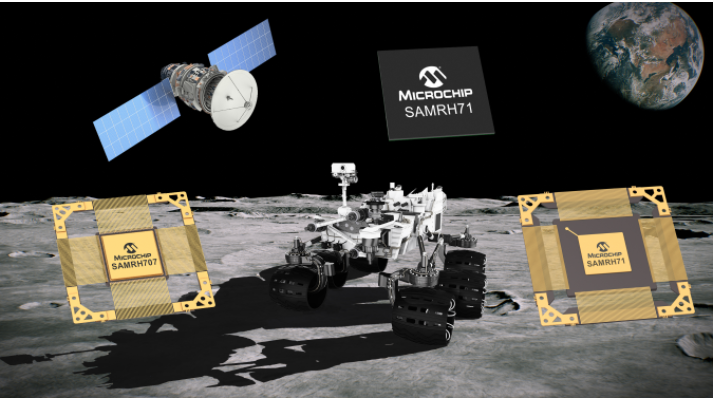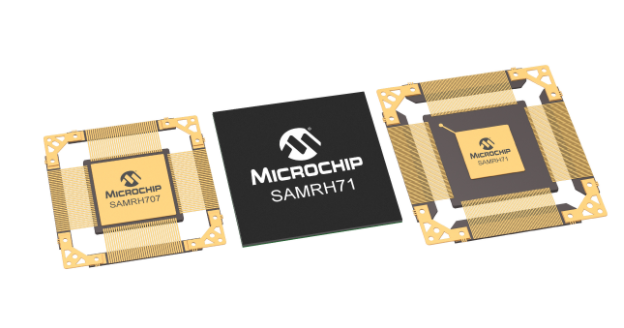April 29, 2021
3191
The new product adopts Arm CortexÒ-M7-based system-on-chip (SoC) commercial off-the-shelf technology (COTS) and radiation-resistant scalable solutions, and adds embedded simulation functions to provide developers with more convenience
Space projects, including planetary exploration, orbiter missions, and space research, require innovative spacecraft system technology to provide connectivity and processing functions. In order to enable system designers to better integrate and improve performance, while reducing development costs and shortening time to market, commercial off-the-shelf technology (COTS) and scalable solutions are increasingly used in space applications. Microchip today announced that its Arm®-based SAMRH71 microprocessor (MPU) has been certified, and the SAMRH707 microcontroller (MCU) has begun to supply. Both products use Arm Cortex®-M7-based system-on-chip (SoC) anti-radiation technology.

Microchip's SAMRH71 and SAMRH707 devices were developed with the support of the European Space Agency (ESA) and French Space Agency National Space Research (CNES) for further research and space missions.
David Dangla, a VLSI component expert at the French National Center for Space Research (CNES), said: "The introduction of Arm technology in space applications has opened up new horizons for us, allowing us to use the mature and complete ecosystem in the consumer and industrial sectors. SAMRH71 is the current market. The first radiation-resistant microprocessor based on Arm Cortex-M7 on the market provides developers with the simplicity of a single-core processor and the performance of an advanced architecture without having to perform heavy mitigation techniques like non-space-grade components."

Kostas Marinis, an airborne computer engineer at the European Space Agency (ESA), said: "Integrating digital-to-analog converters and analog-to-digital converters with a powerful processor core is a key requirement for meeting new challenges in aerospace applications. Microchip's SAMRH707 So that the cost-effective, radiation-resistant single-chip microcomputer has simple and easy-to-use functions."
Based on the standard Arm Cortex-M7 architecture and the same peripherals as automotive and industrial processors, SAMRH71 and SAMRH707 can use standard software and hardware tools for consumer devices to optimize system development costs and schedules.
SAMRH71 is a radiation-resistant version of Microchip's COTS automotive SoC technology. It also provides a spatial connection interface and a high-performance architecture. The DMIPS exceeds 200. The Arm Cortex-M7 core of SAMRH71 is designed for high radiation environment, extreme temperature and high reliability, and is equipped with high-bandwidth communication interfaces, such as SpaceWire, MIL-STD-1553 and CAN FD, and has IEEE1588 General Precision Time Protocol (gPTP). ) Functional Ethernet. With the support of the French National Center for Space Research (CNES), SAMRH71 has obtained ESCC full certification and meets the V and Q high reliability levels of the MIL standard, enabling the system to meet strict compliance requirements.
The SAMRH707 device expands Microchip's product lineup of single-chip microcomputers based on the radiation-resistant Arm Cortex-M7. It provides analog functions on a processor unit with digital signal processing (DSP) functions and DMIPS "100, and combines a spatial connection interface in a small size. Designed for high radiation environment, extreme temperature and high reliability. SAMRH707 achieves a high level of integration, embedded static random access memory (SRAM) and flash memory, high-bandwidth communication interfaces (including SpaceWire, MIL-STD-1553 and CANFD), and analog functions, such as 12-bit analog-to-digital converters (ADC ) And digital-to-analog converter (DAC).
Microchip's microcontrollers, microprocessors and field programmable gate arrays (FPGAs) designed for space applications provide key elements for the development of new systems. Microchip's overall system solutions cover aerospace requirements, radiation-resistant and radiation-resistant power, timing and clock devices, as well as connection and memory solutions.